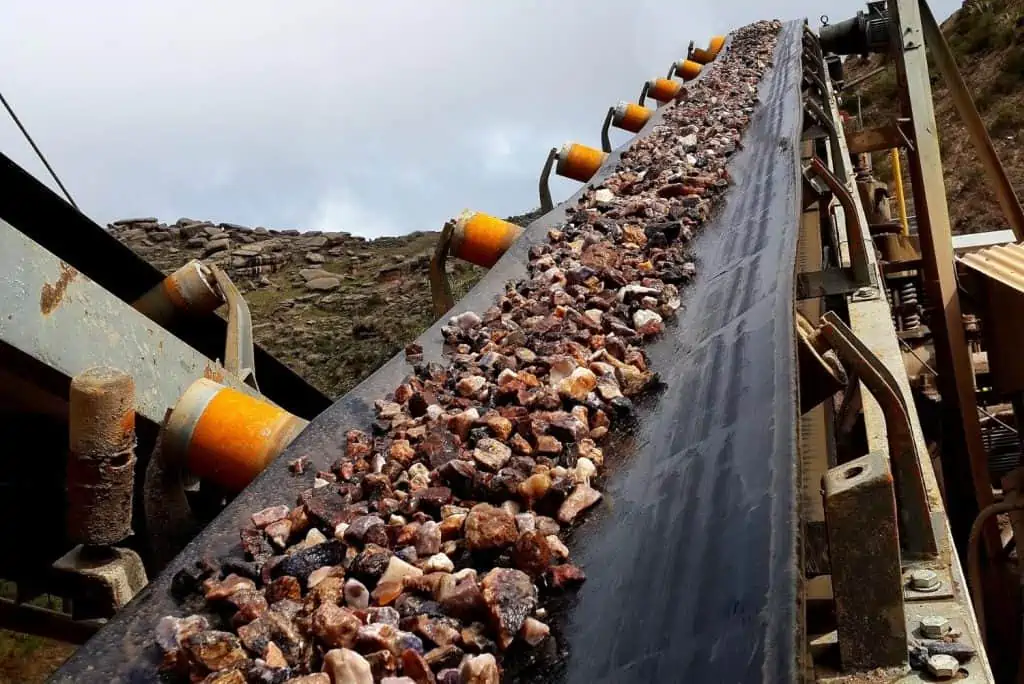Conveying systems are an essential part of modern industry, and they play a critical role in transporting goods and materials across various applications. Whether in mining, manufacturing, or food processing, conveying systems provide a reliable and efficient means of moving materials from one point to another. In this article, we’ll explore the various types of conveyor systems available, their multiple applications, and their benefits.

Types of Conveying Systems
Several conveying systems are available, each of which suits specific applications. The most common types of conveying systems include:
- Belt Conveyors: Belt conveyors are perhaps the most well-known type of conveying system. They consist of a belt made of various materials that move along two or more pulleys. Belt conveyors are often used to move a good amount of goods over long distances, making them ideal for mining and quarrying applications.
- Screw Conveyors: Screw conveyors use a rotating screw to move materials along a trough or tube. They typically move bulk materials, such as grains or powders, over short distances.
- Roller Conveyors: Roller conveyors use a series of rollers to move materials along a flat surface. They are usable in manufacturing applications, such as assembly lines, where there is a need for goods to move from one station to another.
- Pneumatic Conveyors: These conveyors use air pressure to transport materials through pipelines. Their frequent use occurs when moving materials over great distances or to hard-to-reach areas.
Applications of Conveying Systems
Conveying systems are used in various applications, from mining and manufacturing to food processing and packaging. Here are some of the most common applications of conveying systems:
- Mining and Quarrying: Conveying systems are essential in mining and quarrying applications, where they are used to move large quantities of materials over long distances. Belt conveyors are often used in mining applications to transport coal, ore, and other materials to processing plants or storage facilities.
- Food Processing: Conveying systems are critical in the food processing industry, transporting raw materials, finished products, and packaging materials. Belt conveyors are usable in food processing applications, transporting food products from one process stage to another.
- Manufacturing: Conveying systems are widely used in manufacturing applications, where they are used to move materials and products along assembly lines. Roller conveyors are often used in manufacturing applications, transporting products from one station to another.
- Packaging: Conveying systems are also used in packaging applications, where they are used to move products and packaging materials along packaging lines. Belt conveyors are often used in packaging applications, transporting products from one packaging station to another.
Benefits of Conveying Systems
Conveying systems offer several benefits, including:
- Increased Efficiency: Conveying systems are highly efficient, allowing materials to be transported quickly and easily from one location to another. It can increase production rates and reduce the time and labor required to move materials from one place to another.
- Improved Safety: Conveying systems can help improve workplace safety by reducing the need for manual handling of materials. It can reduce the risk of worker injury and improve overall workplace safety.
- Reduced Costs: Conveying systems can reduce costs by reducing the need for labor and increasing the efficiency of material handling. It can reduce operating costs and increase profitability.
- Customization: Conveying systems can be customized to suit specific applications, allowing them to tailor to the unique needs of each application. It can help improve efficiency and productivity and reduce the risk of damage or loss of materials.
- Environmental Sustainability: Conveying systems can reduce the environmental impact of material transportation by reducing the energy required to move materials. For example, pneumatic conveying systems can use compressed air instead of electricity or fuel to move materials, reducing carbon emissions and energy consumption.
- Increased Productivity: Conveying systems can increase productivity by reducing the time and effort required to move materials. It can allow workers to focus on other tasks, improving overall productivity and efficiency.
- Versatility: Conveying systems can transport various materials, from small parts and components to large bulk materials. This versatility makes them ideal for multiple applications, including mining, manufacturing, and food processing.
While conveying systems offer numerous benefits, choosing the right type of system for your application is essential. The selection process should consider the type and quantity of materials transported, the transportation distance, and the production facility’s overall layout. Proper maintenance and inspection of conveying systems are essential to ensure their continued operation and prevent breakdowns or accidents.
In addition to traditional conveying systems, technological advances have led to the developing innovative conveying systems. For example, magnetic conveying systems use magnetic fields to move materials, while conveying systems use cable and tube technology to transport fragile materials. These systems offer unique advantages over traditional conveying methods, such as increased precision and reduced material breakage.
As industries evolve and become more complex, the demand for efficient and reliable material transportation solutions will only increase. Conveying systems will continue to play a vital role in meeting this demand and driving the industry forward. From mining and manufacturing to food processing and packaging, conveying systems will continue providing reliable, efficient, and sustainable means of transporting materials and improving overall productivity.
Conclusion
Conveying systems are an essential part of modern industry, and they play a critical role in transporting goods and materials across various applications. From mining and manufacturing to food processing and packaging, conveying systems offer a reliable and efficient means of moving materials from one point to another. Conveying systems have many advantages that can advance industry, from raising output and efficiency to lowering costs and enhancing sustainability. With a wide range of systems available, including belt conveyors, screw conveyors, roller conveyors, and pneumatic conveyors, it’s easy to find a conveying system that meets the unique needs of your application. Whether you want to increase efficiency, improve safety, reduce costs, or enhance sustainability, a conveying system can help you reach your goals and take your business to the next level.




